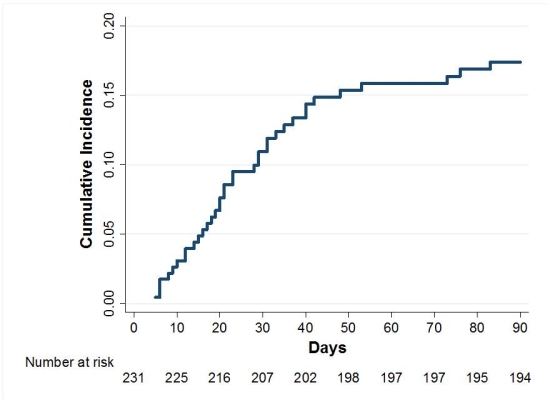Acute Kidney Injury in the Early Post Kidney Transplant Period: Frequency, Etiology and Significance
1Surgery, Dalhousie University, Halifax, NS, Canada
2Medicine, Dalhousie University, Halifax, NS, Canada.
Meeting: 2015 American Transplant Congress
Abstract number: A37
Keywords: Glomerular filtration rate (GFR), Graft function, Kidney, Renal injury
Session Information
Session Name: Poster Session A: Delayed Function/Acute Injury/Outcomes/Glomerulonephritis
Session Type: Poster Session
Date: Saturday, May 2, 2015
Session Time: 5:30pm-7:30pm
 Presentation Time: 5:30pm-7:30pm
Presentation Time: 5:30pm-7:30pm
Location: Exhibit Hall E
Acute kidney injury (AKI) post kidney transplant has not been well described using current diagnostic criteria. The frequency and etiology of AKI in the first 90 days was explored. Since graft function at year 1 is associated with long term survival, the association of AKI and 1 year kidney function was analyzed.
In this center, 231 consecutive adult recipients of a solitary kidney transplant were followed. All were cross match negative and without donor specific HLA antibodies at surgery. AKI was defined as an increase in serum creatinine >26 umol/L or a 1.5 fold increase over 7 days. Cause of AKI was categorized. MDRD GFR at 12 months was the outcome of interest. Only the first episode of AKI was examined.
Table 1 shows the demographics of the population, stratified by no AKI and AKI within 90 days.
| Variable | AKI n=37 | No AKI n=194 | Prob |
| Age yrs mean (SD) | 53 (13) | 48 (13) | 0.058 |
| Female n (%) | 6 (16) | 79 (41) | 0.005 |
| Living Donor n (%) | 14 (38) | 77 (40) | 0.857 |
| Donor Age yrs mean (SD) | 48 (16) | 46 (15) | 0.470 |
| Donor Female n (%) | 15 (41) | 117 (60) | 0.030 |
| DGF n (%) | 8 (22) | 18 (9) | 0.044 |
| HLA MM median (IQR) | 4 (3-6) | 4 (2-5) | 0.471 |
 The causes were rejection (6), urologic (7), infection (3), and pre-renal/ CNI toxicity (18). Several cases could not be classified.
The causes were rejection (6), urologic (7), infection (3), and pre-renal/ CNI toxicity (18). Several cases could not be classified.
Multivariable linear regression analysis reveals that AKI is independently associated with a 5.2 ml/min/1.73m2 (95% CI, -12, -0.5, p=0.04) reduction in eGFR at 12 months. Other significant predictors were age (-0.5 per yr, p=0.001), donor male (+5.2, p=0.005), and DGF (-11.1, p=0.001). In a sensitivity analysis any increase in creatinine >26 umol/L over 7 days occurred in 78 (33.7%) and was associated with a 6.4 ml/min/1.73m2 (95% CI, -10.1, -2,6, p=0.001) reduction in year 1 eGFR in a multivariable model.
Conclusion-Early AKI is common, frequently non-immunologic, and significantly associated with reduced graft function at year one. Further study is required to determine which of the non-immunologic AKI causes are most significant/reversible/preventable.
To cite this abstract in AMA style:
Kiberd B, Cimen S, Tennankore K. Acute Kidney Injury in the Early Post Kidney Transplant Period: Frequency, Etiology and Significance [abstract]. Am J Transplant. 2015; 15 (suppl 3). https://atcmeetingabstracts.com/abstract/acute-kidney-injury-in-the-early-post-kidney-transplant-period-frequency-etiology-and-significance/. Accessed December 14, 2025.« Back to 2015 American Transplant Congress
